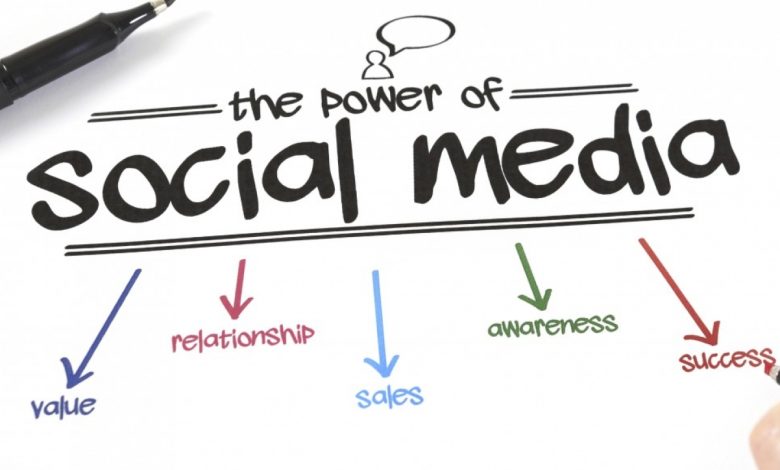How to Use Social Media for Business Growth in 2025: Effective Strategies and Tips

Social media is more than just a platform for connecting with friends and family—it’s become a vital tool for businesses aiming to grow, engage customers, and increase sales. By 2025, social media has firmly established itself as one of the most cost-effective, accessible, and impactful marketing channels. However, to use social media effectively in 2025, businesses need to understand the evolving landscape and adjust their strategies to the ever-changing digital world.
This comprehensive guide provides actionable insights, tips, and strategies on how to use social media for business growth in 2025, ensuring that your brand stays ahead of the competition and builds lasting relationships with its audience.
Table of Contents
Why Social Media Is Crucial for Business Growth in 2025
As technology and consumer behavior continue to evolve, social media platforms have become the backbone of digital marketing strategies. Social media offers businesses an unparalleled opportunity to reach millions of users around the world. Understanding how to use social media for business growth is essential for creating meaningful connections with consumers and generating substantial returns on marketing efforts.
1. Massive Reach and Global Audience
Social media platforms have evolved into global communication networks, making it possible for businesses to engage with audiences across multiple regions and cultures. With billions of users worldwide, platforms like Facebook, Instagram, TikTok, and LinkedIn allow businesses to reach a broader and more diverse audience than ever before.
The ability to tap into global markets gives businesses the opportunity to expand beyond local boundaries, connect with international customers, and diversify their revenue streams. Platforms also enable precise targeting—businesses can fine-tune their audience based on demographic factors such as age, gender, location, and interests.
2. Direct and Real-Time Engagement with Customers
A key advantage of social media is the ability for businesses to communicate directly with customers in real-time. Unlike traditional forms of marketing, which are often one-sided, social media fosters two-way communication. Customers expect brands to respond quickly to their queries, provide assistance, and even engage in casual conversation.
This immediacy builds customer trust and loyalty, as it demonstrates that the brand cares about its audience and is committed to providing value. Real-time engagement also presents businesses with the opportunity to address customer concerns, troubleshoot issues, and strengthen brand relationships on a personal level.
3. Cost-Effective Marketing
Social media marketing remains one of the most cost-effective ways for businesses to promote their products and services. Compared to traditional marketing methods like TV ads, billboards, and radio spots, the cost of running social media campaigns is far lower, making it accessible to businesses of all sizes.
While organic reach has decreased due to algorithm changes, businesses can still leverage highly targeted paid ads to reach their ideal audience at a fraction of the cost of traditional advertising. Additionally, tools such as A/B testing, advanced targeting options, and detailed analytics allow businesses to track their performance and adjust strategies for optimal results.
4. Data-Driven Insights for Smarter Decision Making
One of the key advantages of social media marketing is access to detailed data and analytics. Platforms like Facebook, Instagram, and LinkedIn provide businesses with valuable insights into their audience’s preferences, behaviors, and interactions with content.
In 2025, the availability of such data allows businesses to make smarter, more informed decisions. Social media platforms are equipped with built-in analytics tools that track key performance indicators (KPIs) such as engagement rate, reach, conversions, and click-through rates. Using these insights, businesses can adjust their strategies in real time, ensuring they stay relevant and responsive to audience demands.
Key Social Media Platforms for Business Growth in 2025
To succeed in how to use social media for business growth, it’s essential to choose the right platforms for your brand. Different platforms attract different demographics and offer various tools for reaching your goals. Let’s look at the top platforms that businesses should focus on in 2025:
Facebook remains a giant in the social media world, with more than 2.8 billion active users. The platform’s diverse features—ranging from Facebook Ads to Facebook Groups—allow businesses to connect with customers in multiple ways. It’s particularly beneficial for businesses looking to engage with a broad demographic.
Tips for Facebook Marketing Success:
- Targeted Facebook Ads: Facebook Ads allow you to target users based on their location, interests, behavior, and even past interactions with your business.
- Facebook Live: Hosting live sessions on Facebook lets you engage with your audience in real time, promoting transparency and authenticity.
- Facebook Groups: By joining or creating Facebook Groups related to your industry, you can build a community of engaged followers who are interested in your products or services.
- Content Variety: Use a mix of content types, such as images, videos, polls, and infographics, to maintain engagement and attract new followers.
Instagram continues to dominate as one of the most popular social media platforms for businesses, particularly those in visually-driven industries such as fashion, beauty, food, and travel. With features like Stories, Reels, and Shopping, Instagram offers businesses multiple ways to engage with followers.
Tips for Instagram Marketing Success:
- Instagram Reels: Short, snappy videos that have the potential to go viral. Reels are highly favored by the algorithm and are great for reaching new audiences.
- Instagram Shopping: This feature allows businesses to showcase their products and sell directly through Instagram, streamlining the shopping experience for customers.
- Collaborate with Influencers: Influencers are powerful allies in growing your brand on Instagram. Partner with influencers whose audience matches your target demographic.
- Consistent Visual Branding: Ensure that your Instagram feed is visually cohesive, which reinforces your brand identity.
LinkedIn is the premier platform for B2B marketing, networking, and professional development. It’s a powerful tool for businesses that aim to establish themselves as thought leaders and build professional relationships.
Tips for LinkedIn Marketing Success:
- Long-Form Content: Publish articles, case studies, and insights to position yourself as an authority in your field.
- Networking: Engage with potential partners, collaborators, and clients through comments, messages, and group discussions.
- LinkedIn Ads: LinkedIn Ads are excellent for targeting professionals based on job titles, industries, company size, and other factors, making it an ideal platform for lead generation.
- Company Page: Optimize your LinkedIn company page with up-to-date information, engaging content, and job postings to attract top talent and customers.
TikTok
TikTok’s rapid rise to prominence in recent years has cemented its position as a key social media platform for brands targeting younger audiences. TikTok’s algorithm favors engaging, short-form videos, and its focus on authenticity and creativity offers a unique opportunity for businesses to build strong brand awareness.
Tips for TikTok Marketing Success:
- Create Viral Content: Embrace the platform’s trends and challenges to create viral content that resonates with your audience.
- User-Generated Content: Encourage your followers to create and share content related to your brand, increasing your reach and engagement.
- Collaborate with Creators: Work with TikTok creators who have a large, engaged following to expand your brand’s reach.
- TikTok Ads: TikTok’s native ad formats, such as In-Feed ads and Branded Hashtag Challenges, offer businesses unique ways to promote their products.
How to Use Social Media for Business Growth in 2025: Key Strategies
To make the most of social media in 2025, businesses must employ targeted, effective strategies. Here are key strategies to ensure that you’re using social media in the most impactful way possible for business growth: How to Use Social Media for Business Growth
1. Define Clear Social Media Goals
Setting clear, measurable goals is the first step in any successful social media marketing campaign. Whether your objective is to build brand How to Use Social Media for Business Growth awareness, drive website traffic, generate leads, or increase sales, your goals will guide the types of content you create, the platforms you use, and the tactics you employ.
Common social media goals include:
- Increasing Engagement: Boosting likes, shares, comments, and mentions on your posts.
- Lead Generation: Using content and paid ads to attract potential customers and capture leads.
- Building a Community: Creating a loyal following by interacting with customers and encouraging brand advocates.
- Boosting Sales: Directly driving e-commerce sales through platforms like Instagram and Facebook Shops.
2. Know Your Audience Inside and Out
Understanding your audience is essential for creating content that resonates. Conduct thorough research on your target audience, analyzing factors such as: How to Use Social Media for Business Growth
- Demographics: Age, gender, location, and income.
- Interests: Hobbies, passions, and lifestyle choices.
- Online Behavior: Which social platforms do they use? How do they engage with content?
Use insights from social media analytics tools to refine your understanding of your audience. This will allow you to tailor your content strategy to meet their preferences and needs.
3. Create Highly Engaging and Shareable Content
Content is the heart of any social media strategy. In 2025, businesses need to focus on creating content that not only informs but also entertains and inspires.
Types of engaging content include:
- Video Content: Video continues to outperform other types of content on social media. Whether short-form or long-form, videos tend to generate higher engagement rates and allow brands to showcase their products in dynamic ways.
- Infographics: Infographics break down complex information into easy-to-digest, visually appealing formats.
- Interactive Content: Polls, quizzes, and contests keep your audience engaged and encourage them to participate.
- User-Generated Content (UGC): Encourage your customers to create content featuring your products. UGC not only builds trust but also expands your reach by tapping into your followers’ networks. How to Use Social Media for Business Growth
4. Leverage Influencer Marketing
Influencer marketing remains one of the most powerful strategies in 2025. Partnering with influencers allows businesses to tap into a How to Use Social Media for Business Growth pre-established, loyal audience. Choose influencers whose values align with your brand and whose followers match your target demographic.
Influencers can create content that feels authentic and relatable, helping your brand gain credibility and trust within your target market.
5. Harness the Power of Paid Social Media Advertising
With organic reach on many platforms declining, paid social media advertising is an essential part of any marketing strategy. Paid ads allow businesses to:
- Target Specific Audiences: Use advanced targeting to reach users based on demographics, behaviors, and interests.
- Increase Visibility: Boost your content to reach a broader audience, including those who may not follow your page.
- Optimize Campaigns: Track the performance of your ads in real time, enabling you to make adjustments and optimize for better results.
6. Build a Community and Encourage Engagement
Building a community around your brand fosters a sense of loyalty and belonging. Social media offers numerous ways to engage with your audience and make them feel heard:
- Reply to Comments: Always engage with comments on your posts, answering questions and showing appreciation for positive feedback.
- Host Live Sessions: Use live video to engage with your followers in real time, answering questions and creating a personal connection.
- Create Polls and Surveys: Ask for feedback and opinions from your audience to involve them in the decision-making process.
7. Measure and Analyze Performance
Regularly track the performance of your social media efforts. Key metrics to track include:
- Engagement Rate: Likes, comments, shares, and other interactions with your posts.
- Website Traffic: Monitor how much traffic is being driven from social media to your website.
- Conversions: Measure how many social media interactions translate into actual sales or leads.
By evaluating your social media metrics, you can identify what’s working and where there’s room for improvement.
Advanced Social Media Strategies for Business Growth in 2025
To truly excel in how to use social media for business growth, businesses must stay ahead of the curve by implementing advanced strategies. Here are some innovative tactics to consider: How to Use Social Media for Business Growth
1. Social Commerce
Social commerce is the future of online shopping, and 2025 will see more businesses leveraging social media platforms to sell products directly. How to Use Social Media for Business Growth Features like Instagram’s Shopping and Facebook Shops make it easy for customers to purchase products without ever leaving the platform.
2. AI-Powered Marketing Tools
In 2025, artificial intelligence (AI) will be a key driver of social media success. AI can automate content creation, optimize ad targeting, and even predict trends. AI-powered chatbots are already improving customer service, and machine learning can help brands better understand customer behavior.
3. Real-Time Marketing and Social Listening
By using social listening tools, businesses can monitor conversations in real-time, track trending topics, and quickly adjust marketing strategies. Engaging in timely conversations around trends, breaking news, or viral moments can elevate your brand’s presence.
Conclusion
In 2025, how to use social media for business growth is no longer just a question of creating posts and ads—it’s about building authentic connections, leveraging data, and staying ahead of the curve with innovative strategies. Social media is a vital tool for businesses looking to expand their reach, engage customers, and increase sales. By choosing the right platforms, understanding your audience, and consistently refining your strategy, you can drive significant business growth in the ever-evolving digital world.
Social media presents limitless opportunities for businesses to interact with customers, build brand loyalty, and increase revenue. Stay proactive, keep experimenting with new tools and tactics, and adapt to the changing landscape to ensure your brand thrives in 2025 and beyond.
Frequently Asked Questions (FAQs)
1. How can small businesses benefit from social media in 2025?
Small businesses can leverage social media to level the playing field with larger competitors by creating personalized content, engaging with customers directly, and running targeted ads. Social media’s cost-effectiveness and ability to build community make it an essential tool for small business growth.
2. Which social media platform is best for B2B businesses?
LinkedIn is the best platform for B2B businesses. It offers advanced targeting features, professional networking, and content-sharing options that are ideal for building thought leadership, establishing credibility, and generating business leads.
3. Is influencer marketing still effective in 2025?
Yes, influencer marketing is still highly effective in 2025. Micro-influencers, in particular, are gaining popularity due to their niche audiences and higher engagement rates. Businesses can build authentic relationships with influencers to increase brand awareness and trust.
4. How can businesses stay relevant on social media in 2025?
To stay relevant, businesses must focus on understanding evolving customer behaviors, adapting to new social media trends, and engaging with their audience in real-time. Regularly updating content strategies, embracing new features on social platforms, and experimenting with new forms of content will help businesses stay ahead.
5. What are the key metrics to measure success on social media?
Key metrics include engagement rate (likes, shares, comments), reach, website traffic, conversion rate, and return on investment (ROI). Tracking these metrics will help businesses evaluate their social media performance and refine their strategies for better results.

